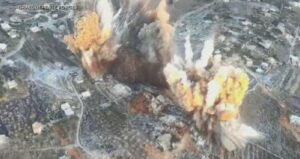The war between Russia and Ukraine has been anything but predictable. Just when we think we’ve figured out the situation, something changes.
It’s now been over 30 months since Russia launched its so-called “special military operation” in Ukraine—an unprovoked invasion that has cost hundreds of billions of dollars, displaced millions, and claimed countless lives.
In this case, it’s not just soldiers on the ground or drones in the air—it’s Russia physically moving its military assets out of harm’s way.
You might be wondering, “Why does this matter?” Well, it’s more than just a back-and-forth between the two sides. It shows a broader shift in strategy that could seriously affect how this conflict plays out in the months ahead.
Here’s the latest situation report on the Russo-Ukrainian War.
Russia’s Move: Out of Range, Out of Reach
Recently, Russia has begun relocating its key military assets—particularly aircraft—farther away from Ukraine’s borders.
Why? Because Ukraine has been getting some serious firepower from the United States, like the Army Tactical Missile System (ATACMS ), which can hit targets up to 300 kilometers (or about 186 miles) away.
But here’s the kicker: 90 percent of Russia’s aircraft are now stationed beyond that range.
Many experts think that this isn’t just a random move; it’s a calculated shift aimed at keeping their warplanes safe while still maintaining their offensive capabilities.
John Kirby, the White House National Security Communications Advisor, confirmed this last week’s press briefing, stating that Russia has effectively shielded the majority of its air force from these American-made long-range missiles.
While Kyiv has been pushing to use these weapons to strike inside Russian territory, the US has maintained strict geographic limits, and Russia’s relocation justifies that stance.
“The argument that somehow if you just give them an ATACMS and tell them it’s okay that they’re going to be able to go in and hit the majority of the Russian aircraft and airbases that are in fact used to strike them is not true,” Kirby explained. “It’s a misconception.”
Is This a Sign of Vulnerability?
Here’s where things get interesting.
By moving their aircraft and other assets, Russia is showing us something: they’re vulnerable.
Sure, their planes might be safe for now, but the fact that they had to retreat deeper into their own territory shows that they’re feeling the pressure.
Ukraine’s growing capabilities, with the help of Western weapons, have forced the Kremlin to make defensive moves that weren’t necessary a few months ago. And that’s a big deal.
But this also raises some big questions. Is Russia afraid that Ukraine might get even more advanced weaponry in the future? Could this be a signal that they anticipate Western nations, particularly the US, might eventually provide Ukraine with even longer-range systems that could reach those newly relocated assets? These are the kinds of chess moves that keep military analysts up at night.
Ukraine’s Response: Adapt or Fall Behind
So, where does this leave Ukraine? With Russia moving its assets out of reach, Kyiv’s military is going to have to get creative.
Relying solely on long-range missile systems like ATACMS won’t cut it if the targets they want to hit are suddenly too far away.
Instead, Ukraine might need to shift its strategy, focusing more on intelligence operations, drone warfare, and perhaps even finding new ways to counteract Russia’s long-range strikes.
There’s also the diplomatic angle.
Ukraine’s President Zelensky has been relentless in pushing for the freedom to strike deeper into Russian territory, believing it’s the only way to truly halt these constant air attacks. But, as we’ve seen, the US is cautious about letting this happen, fearing it could escalate the war beyond Ukraine’s borders.
However, Russia’s recent moves could add more weight to Zelensky’s pleas.
Suppose Ukraine can argue that Russian aircraft are no longer operating near the border and continue to strike with impunity.
In that case, it might convince some Western allies to reconsider their stance on providing longer-range weapons.
What This Means for US and NATO Policy
What we think this means for US and NATO policy is that Russia’s move isn’t just about keeping their assets safe—it’s about sending a message.
By moving their planes out of ATACMS range, Russia is showing the West that they’re still in control and they can adapt to whatever Ukraine throws at them.
But this could also have the opposite effect: it might push the US and NATO to rethink their approach. If Ukraine’s current arsenal isn’t enough to prevent these airstrikes, could this lead to a shift in policy? Maybe even a green light for more advanced, longer-range weapons?
It’s a fine line, though. The West has been careful about escalating the conflict, but if Russia continues to push the limits, we could see a change in the type of support Ukraine receives.
More Missiles or More Talks? The Next Move
This shift in strategy goes far beyond missiles and airstrikes—it’s about recalibrating the entire war effort.
Russia’s repositioning of military assets hints at a broader strategic overhaul, one that could reshape not only the battlefield but also the international response.
On one hand, it might prompt Western nations to increase their military support for Ukraine, fearing further escalation.
On the other, it could push some countries toward pursuing diplomatic solutions, especially if the conflict drags on with no decisive outcome in sight.
Meanwhile, Ukraine is grappling with a surge in attacks on its civilian and energy infrastructure, like the recent missile barrage on Poltava.
President Zelensky has been vocal about his country’s need for more advanced defense systems, arguing that the only way to halt these Russian strikes is by targeting the very launch sites and airfields behind them.
Yet, despite these pressing concerns, the US remains steadfast in its stance—no direct strikes inside Russian territory, a boundary that adds complexity to Ukraine’s efforts to defend itself.
Wrapping It Up: The War’s Next Chapter
Russia’s decision to relocate its military assets marks the beginning of a new phase in this conflict. Both sides are adapting, and the balance of power is constantly shifting.
For Ukraine, the challenge will be to find ways to continue defending itself and pressuring Russia, even as its adversary moves key assets out of reach.
For the US and NATO, the question is whether to stick with their current strategy or adjust their support in response to Russia’s moves.
One thing is certain: this war is far from over, and both countries’ strategies will evolve. How Ukraine responds to this latest shift, and how the West decides to support them, could determine the conflict’s future.
—
Disclaimer: SOFREP utilizes AI for image generation and article research. Occasionally, it’s like handing a chimpanzee the keys to your liquor cabinet. It’s not always perfect and if a mistake is made, we own up to it full stop. In a world where information comes at us in tidal waves, it is an important tool that helps us sift through the brass for live rounds.



